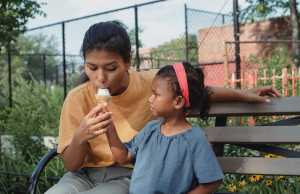- Child discipline is tricky business: as there is a wide range of strategies and techniques that can (or actually can’t) get the job done.
- So which one’s do get the job done? According to science, the authoritative parenting style proves the most effective; this involves encouragement and clear communication.
- Another useful technique involves giving your child options—instead of just saying no when they can’t do or have something, suggest something they can do or have.
- Additionally, instead of employing the timeout method, you should try getting on your child’s level, taking them to a quiet space, or simply asking what’s wrong.
- Finally, prioritizing relationship building can make a huge difference: it can aid you when it comes to disciplining your children and it can also improve your relationship with your child so that they are less likely to act out.
Imagine you’re out at a nice dinner with your spouse: it’s a quaint restaurant with polite staff, and candles sit on each table, illuminating the space beautifully. You’re enjoying your meal—spaghetti and meatballs—and smiling graciously at your loved one… when a sharp cry slices through the delightful ambiance that was. Everyone in the restaurant looks around to identify the child (and the child’s parents) who is throwing the noisy tantrum and ruining everyone’s peace and quiet.
It’s easy to roll your eyes in situations of the like. But what if you imagined your night out a little differently… you’re out at a nice dinner with your family: it’s the same quaint restaurant with polite staff, illuminating candles sitting on each table. You’re each enjoying your meals—different Italian cuisines—when your child lets out a sharp cry. Everyone in the restaurant stares at you and silently begs you to calm your 5-year-old down. What do you do?
This could go a number of ways, depending on your approach to child discipline. You could yell at your child to quiet down… you could bribe your 5-year-old with a reward if he stops crying… or you could simply let him cry it out. But in all honesty, none of these approaches will yield great outcomes. The following, on the other hand, will prove more effective:
1) Be “authoritative.”
Dr. Kimberly Kick, a licensed clinical social worker, cites a research-backed parenting method: the authoritarian style. “Over the years, the best approach to disciplining your children has evolved from authoritarian (do as I say—fear-based) to authoritative,” she says. “Numerous studies have indicated the positive affect of adopting an authoritative style of parenting. Characteristics of parents who raise their children using the authoritative style are warm and affectionate and communicate acceptable behavior and expectations, yet they encourage their children to be expressive and independent.” That said, many parents still continue to utilize physical discipline and believe it is the best approach. “In reality,” she says, “children fare much better in authoritative households where expectations are clearly stated, while the parents set clear limits and guidelines and encourage thoughtfulness and independence in their children.”
2) Don’t just say no—offer an alternative plan.
Elizabeth Malson, President of Amslee Institute, recommends adjusting your feedback. Instead of just saying “no” to your child, suggest an alternative. She explains: “As part of our quest to encourage desired behavior, we tend to say the word ‘no’ quite a bit. It’s easy and clear. At times, though, it can be discouraging or create doubt in children. It’s okay to say no, but parents can also alter their wording to achieve the same goal with the child. For example, a child comes to you wanting to watch TV because they’re bored. Rather than just saying ‘no, you can’t watch TV,’ you might say, ‘Instead of watching TV let’s come up with another activity so you aren’t bored. Do you want to write or read a story, act in a play, or put a puzzle together?’”
3) Forego the traditional timeout method.
Additionally, you should resist putting your child in a timeout when they act out. There are other techniques that prove more effective: “As part of an Early Childhood Education curriculum, I do not recommend the time-out method,” says Mary Anderson, Early Childhood Education-Program Director at Bryant and Stratton College. “In fact, child care licensing rules prohibit the use of the time-out method. Some alternatives are: 1) Redirection: engage the child in a different activity. 2) Squat down and talk to the child on their level and try to find out what’s wrong. 3) If they need to be removed from a situation, do not use a chair, but rather, take them to a quiet space and let them calm down and then talk to them. Then, you can give them two choices for what happens next. The goal would be to try and figure out what is causing the tantrum. Is the child tired, hungry, overstimulated, or just in need of some attention? Try to get the child to verbalize what is wrong and give them alternatives for getting their needs met in the future.”
4) Prioritize relationship building.
Finally, put some time and effort into relationship building. According to Brittany Freeman Jean-Louis, licensed professional counselor and CEO of A Freemans Place Counseling, doing so will benefit you in a number of ways: “Oftentimes, parents do not know the key to discipline is relationship building. Communicate with your children about everything: current events, school, friends, peer pressure, drugs, family. Participate with them in the things they are interested in. Be present and hear them out when they have a concern. Validate their concerns and let them know you are always there for them. When you have this type of open communication with your children, they are less likely to do things that disappoint you. Of course, your children will disappoint you, yet it may happen less than more as you make relationship building a priority. Even when you do discipline your children, the relationship building will help with having those hard conversations.”













